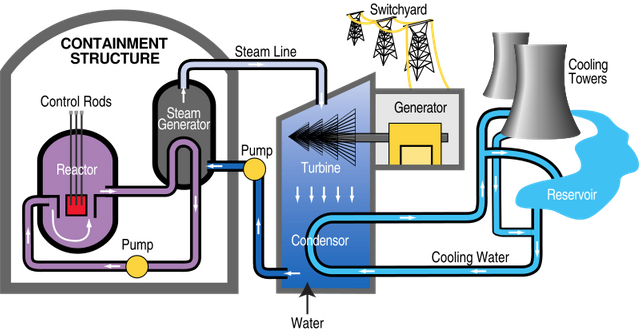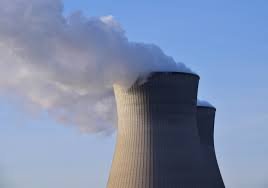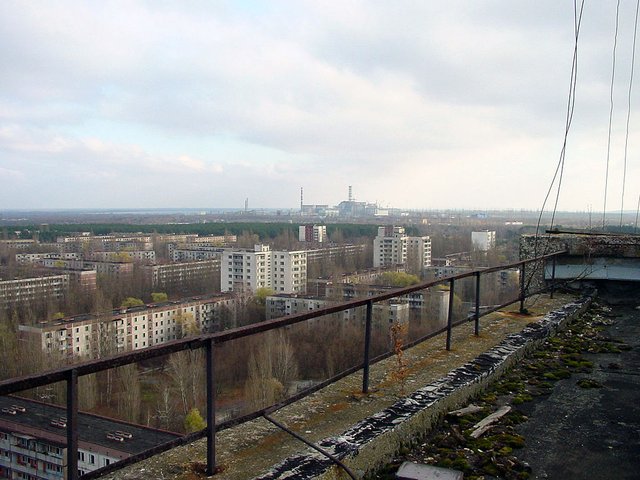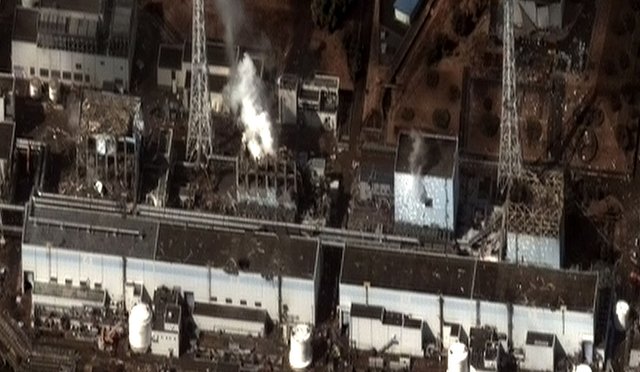REACTORS AND NUKES WHICH HAS PROOVED DEADLIER
So we kick off from our last footing and we seek to bring a safe landing to this series, if we use nuclear fission to generate energy, then I think we need to see the principle via which the energy is generated and use of course as said in the first part of the series, the generated energy is in form of heat and used to turn water to steam as in other power plants. Though in other power plants, the primary energy source is Coal or Oil.
Since the first Nuclear Power Plant opened in the year 1956 in England, the World has been cut between either enduring the climate change brought about by fossil fuels or embracing the nuclear power plant innovation despising the nuclear waste or even a possible accident that might emanate from the plant.IF BOTH NUCLEAR PLANT AND NUCLEAR BOMB IS MADE POSSIBLE BY FISSION, WHAT THEN IS THE DIFFERENCE
The above question, (though rephrased) is the question I promised to answer in the first part of this series, but you see, there are 2 basic difference between the design of the fission Nuke and a power plant, the first is in the nature of the material used while the second is in the design of the reaction core (i.e. where the reaction takes place)
Majorly, the grade of Uranium used for Weapons is quite different from that used in Reactors and power plant, Nukes need pure Uranium 235 to detonate while Power plants requires less purified grades of Uranium (Uranium 238). Because impure Uranium grades limits chain reaction therefore can be used to generate heat just sufficient for the boiler of the plant and not one which would cause much trouble.
During a fission reaction, there is what is called (as I said in the first part) “”The chain reaction”. This reaction as the name implies means that the splitting process of the Radioactive material is continuous and releasing energy in a multiple form due to the geometric increase in the number of neutrons of each process and hence increase in energy though all these will happen in a fraction of a second, however for a Nuke, the overall energy realized from this process would be high enough to destroy a large mass.
On the Eve of the Second World War, Albert Einstein wrote to Roosevelt telling him how that he had discovered a way to fashion Uranium into a WMD, he never knew that letter would at some point lead to the death of several thousands of lives in Hiroshima and Nagasaki. Einstein was a theoretical Physicist who was just doing his thing propounding the mass-energy relation.
It was a Hungarian Scientist Leo Szilard being his close friends who found a way to make it into an atomic bomb. Though keeping his ideas from publication. He tried to make other scientists understand that it is real and if the Nazis should develop it first, then they would have an upper hand in the war and who knows the war might have gotten over sooner than it started.
However, in Nuclear power plants, the chain reaction is controlled by moderators, and by virtue of design which we would look into in more detail now. This design removes excess neutrons to prevent I from re-bombarding the Uranium material, this way, heat provided due to fission is controlled and doesn’t get escalated into a bomb.
Construction of the reactor

Reactor Schematics;Wikimedia commons under public domain
A nuclear reactor can simply be described as the enclosure to which controlled fission would take place. It is basically made of a reinforced concrete casing strong enough to withstand explosion, it has an array of fuel rods with each of these rods containing Uranium dioxide pellets. For further control of the fission process, the fuel may contain Boron or Gadolinium.
In the reactor we have the moderators whose function has already been stated, materials usually used for moderators includes graphite or heavy water, the action of graphite is better than water, however there is an undesirable effect of exposing graphite to the fuel radiation in the core.
One of the most important component of the core is the coolant, this is because of the coolants application to taking heat out of the reactor. In the process of taking the heat out of the reactor, it cools it thereby preventing the reactor from overheating or even explosion. Examples of coolants that can be used is water, CO2 etc.
However, seeing that Water can both serve as a coolant and a moderator at the same time, it is commercially feasible to use water as a coolant In reactors. The coolant reactors are chosen based on its coefficient of heat transfer, i.e Substances with a higher coefficient of heat capacity as this allows for maximal transfer of heat energy from the reactor. It should also have a low viscosity to ease up its flow through the reactor.
One thing we will not fail to talk about in the construction of the reactor is the control rod, as we will consider soon, the control rod is an automated mechanism having the ability to start or abruptly stop the fission process in the case of any emergency call, it has total control over power distribution all through the nuclear reactor.
Control rods are basically made up of materials such as Cadmium, Boron carbide, Indium which can stop the nuclear reactions by absorbing the neutrons. The number of control rods used in a reactor is dependent mainly on the reactor size.
No matter the power of the reaction, the fuel always has to be kept rigid throughout the process. Depending on the design of the reactor, the fuel might be kept vertically or horizontally rigid.
Now there are different type of reactors, which ranges from the Light water reactors to the heavy water reactors to the fast breeder reactors to the graphite moderated reactors, these reactors mentioned vary in the type of material that makes up their moderator, coolant, quality of fuel used (low enriched, high enriched or natural Uranium) and even external structure.
For instance, as the name implies, the coolant of the Light water reactor is water and for that of the heavy water reactor is deuterium. In some types of Light water reactors e.g. Boiling water reactors, the steam is generated inside the reactor and is transferred into turbine for electricity generation. While in Pressurized water reactor, the steam is generated outside the reactor and is transferred outside.
GUESS WHERE THE MOST RADIOACTIVE PLACE ON EARTH SPRUNG OUT FROM… NUKES OR REACTORS.
The top 2 most radioactive places in the world today were not brought about by Nukes, but sprung out of nuclear power plant accident in the reactors. One might have argued that it’s Hiroshima or even Nagasaki (Where the first Nuclear bombs ever took off), well while the number of people that must have died in those events, the most radioactive place on earth today is Fukushima in Japan and Chernobyl in Ukraine.
In fact report has it that the radiation released from the reactor accident in Chernobyl was 100 times higher than that of Hiroshima, It is said about 6 million were exposed to the radiation at Chernobyl and these people have increasingly been reported to have cancer.
BUT HOW SO?
It was April 26 1986 in Chernobyl Pripyat in Ukraine Soviet Union where the was an explosion in the 4th reactor which sent some heavy doses of radiation into the atmosphere. Sweden and Finland first reported a high level of radioactivity In their skies before they were acknowledged by the Soviet government that they actually had an accident. But we are more interested in the science of the accident.
The first thing to note is that the explosion took place during an experiment, they were trying to see how the plant would operate without power supply, it was meant to be a successful experiment but the operators made certain mistakes, they carried out the experiment assuming there was no power supply thereby shutting down all safety devices that depended on electricity, example was the turbine system which was used to pump fresh water into the reactor (the coolant).
Then the water began to overheat into steam with no fresh water coming into the reactor. If something was not done Fast and then, the explosion was inevitable, so the next instinct was to insert the control rods immediately to stop the fission by absorbing the neutrons. But the control rod mechanism jammed due to a reactor design flaw, the steam build up then caused an explosion in reactor 4 which in turn caused a release of radioactive materials to the atmosphere.
HOW ABOUT FUKUSHIMA
At times, the failure of a plant doesn’t have to be about the human mistakes of design flaws, in fact Japans nuclear plant was running optimally before the Tsunami (a Natural disaster which followed an earthquake) shut down the electricity supply and thus disabled the cooling mechanism of the plant, therefore a situation similar to Chernobyl occurred only that this time, three reactors cooling system were affected, good thing about these accident was that though more serious than Chernobyl, there was no case of death recorded as about 100,000 people were relocated from these area to ensure these.
It started with an earthquake, which apparently posed no serious damage to the reactor apart from shutting down the power supply (by virtue of design) The stand-by generator however started almost immediately the power went off, these standby generators maintained cooling throughout the reactor until ultimately, the Tsunami occurred submerging the water pumps thereby leaving the first three reactor to overheat and hence explode. The 5th,6th and 7th reactor wasn’t functioning at that point.
CONCLUSION
Nuclear power is great however great precautions must always be thorouhly taken to ensure that things don't go overbar.
References
How Chernobyl disaster happened
Chernobyl; What happened and why?
How Fukushima disaster happened
If you write STEM (Science, Technology, Engineering, and Mathematics) related posts, consider joining #steemSTEM on steemit chat or discord here. If you are from Nigeria, you may want to include the #stemng tag in your post. You can visit this blog by @stemng for more details.

You can also join us at Promo-Mentors, to improve your blogging skills. Join our discord channel and meet awesome mentors who are willing and ready to shape your writing skills.




Hello! I find your post valuable for the wafrica community! Thanks for the great post! We encourage and support quality contents and projects from the West African region.
Do you have a suggestion, concern or want to appear as a guest author on WAfrica, join our discord server and discuss with a member of our curation team.
Don't forget to join us every Sunday by 20:30GMT for our Sunday WAFRO party on our discord channel. Thank you.
This post has been voted on by the steemstem curation team and voting trail.
There is more to SteemSTEM than just writing posts, check here for some more tips on being a community member. You can also join our discord here to get to know the rest of the community!
Hi @lawkay!
Your post was upvoted by utopian.io in cooperation with steemstem - supporting knowledge, innovation and technological advancement on the Steem Blockchain.
Contribute to Open Source with utopian.io
Learn how to contribute on our website and join the new open source economy.
Want to chat? Join the Utopian Community on Discord https://discord.gg/h52nFrV
Oooo, the main difference between nuke and reactor is the amount of heat produced.
Am fascinated by this Nuclear Physics publish